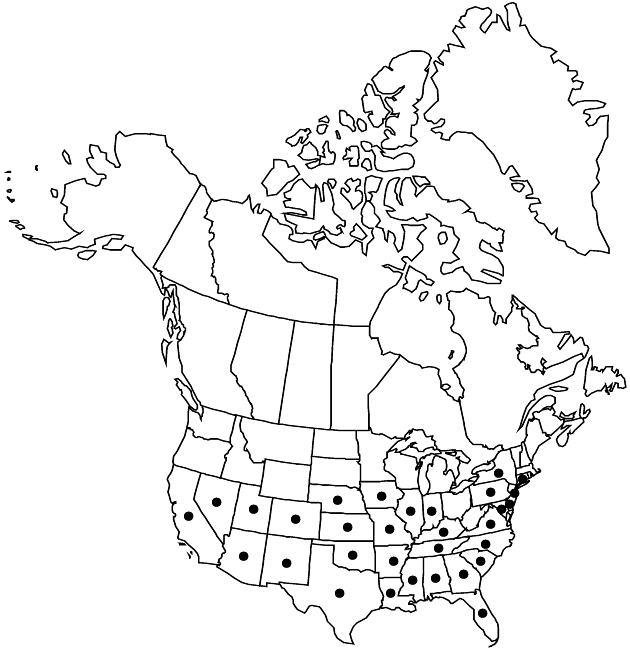Heterotheca subaxillaris
Trans. New York Acad. Sci. 7: 10. 1887.
Annuals or biennials, 10–200 cm (aromatic); taprooted (rarely perennating in south from proximal stem nodes). Stems 1–4+, procumbent to erect (sometimes reddish-brown, proximal to distal branches well developed in larger plants), sparsely to densely hispido-strigose, sparsely to densely stipitate-glandular. Leaves: basal and proximal rarely persisting to flowering, sometimes present and withered, brown to black; basal to mid cauline petiolate (petioles 10–40 mm, bases auriculate-clasping), blades ovate to elliptic or lanceolate, 10–70 × 6–55 mm, bases cuneate to attenuate, margins flat or undulate, coarsely serrate or entire, basally long-ciliate, apices acute, faces moderately hispido-scabrous; distal sessile, blades ovate to lanceolate, 10–90 × 2–20 mm, reduced distally, bases often becoming cordate distally, subclasping or not clasping, margins entire, faces sparsely to moderately hispido-strigose, sparsely to densely stipitate-glandular. Heads 3–180+ in corymbo-paniculiform arrays, sometimes becoming profusely branched (loosely paniculiform or broadly corymbiform in larger plants), branches ascending to spreading. Peduncles 2–35 mm, sparsely to densely hispido-strigose, moderately to densely stipitate-glandular; bracts 0–4, proximal leaflike, ovate to lanceolate, reduced distally and becoming linear, faces sparsely to moderately hispido-strigose, sparsely to densely stipitate-glandular. Involucres hemispheric to campanulate, 4–8 (–10) mm. Phyllaries in 4–6 series, lanceolate, sometimes strongly unequal, margins scarious and distally strigoso-ciliate, faces sparsely to densely stipitate-glandular, with 0–28 coarse, scabro-strigose hairs distally. Ray-florets 15–35; laminae 3–7 (–9) × 1–2 mm. Disc-florets 25–60; corollas weakly ampliate, 2–9 mm, proximal throats glabrous to sparsely short-strigose, lobes 0.5–0.7 mm, glabrous. Cypselae dimorphic, obconic, ribs 2–3, (ray) triangular in cross-section, 1.5–2.5 mm, faces glabrous to slightly strigose, (disc) laterally compressed, 2–4 mm, faces moderately to densely strigose; pappi 0 (ray) or (disc) tan to rust, outer of linear to triangular scales 0.25–0.6 mm, inner of 25–45 bristles 4–9 mm, longest weakly clavate. 2n = 18.
Distribution

Ala., Ariz., Ark., Calif., Colo., Conn., Del., Fla., Ga., Ill., Ind., Iowa, Kans., Ky., La., Md., Miss., Mo., N.C., N.J., N.Mex., N.Y., Nebr., Nev., Okla., Pa., S.C., Tenn., Tex., Utah, Va., Mexico
Discussion
Subspecies 2 (2 in the flora).
Heterotheca subaxillaris is a very weedy, morphologically variable species that has been treated as three species (B. L. Wagenknecht 1960; V. L. Harms 1965, 1970; J. C. Semple 1996) or as a single polymorphic species (G. L. Nesom 1990e). Harms (1965) acknowledged the difficulty in finding consistent characters to separate plants on a geographic basis, as did Nesom (1990e). Harms (1970) noted that H. psammophila and H. latifolia are probably conspecific. It seems best to treat the complex as a single polymorphic species. In historic times, human-assisted dispersal of possibly once distinct races has likely resulted in blurring of such distinctions with one exception. Plants of the outer coastal plain from Texas to North Carolina usually have a cluster of coarse hairs near the tip of phyllaries, at least in summer and fall-blooming plants.
Selected References
None.
Key
| 1 | Outer and mid phyllaries with apical tuft of 6–28 coarse, scabro-strigose hairs; coastal plain, Texas to Delaware | Heterotheca subaxillaris subsp. subaxillaris |
| 1 | Outer and mid phyllaries without distinct apical tuft of hairs (sometimes distally with 1–2 coarse, scabro-strigose hairs); throughout s United States | Heterotheca subaxillaris subsp. latifolia |
"[" is not declared as a valid unit of measurement for this property."]" is not declared as a valid unit of measurement for this property.